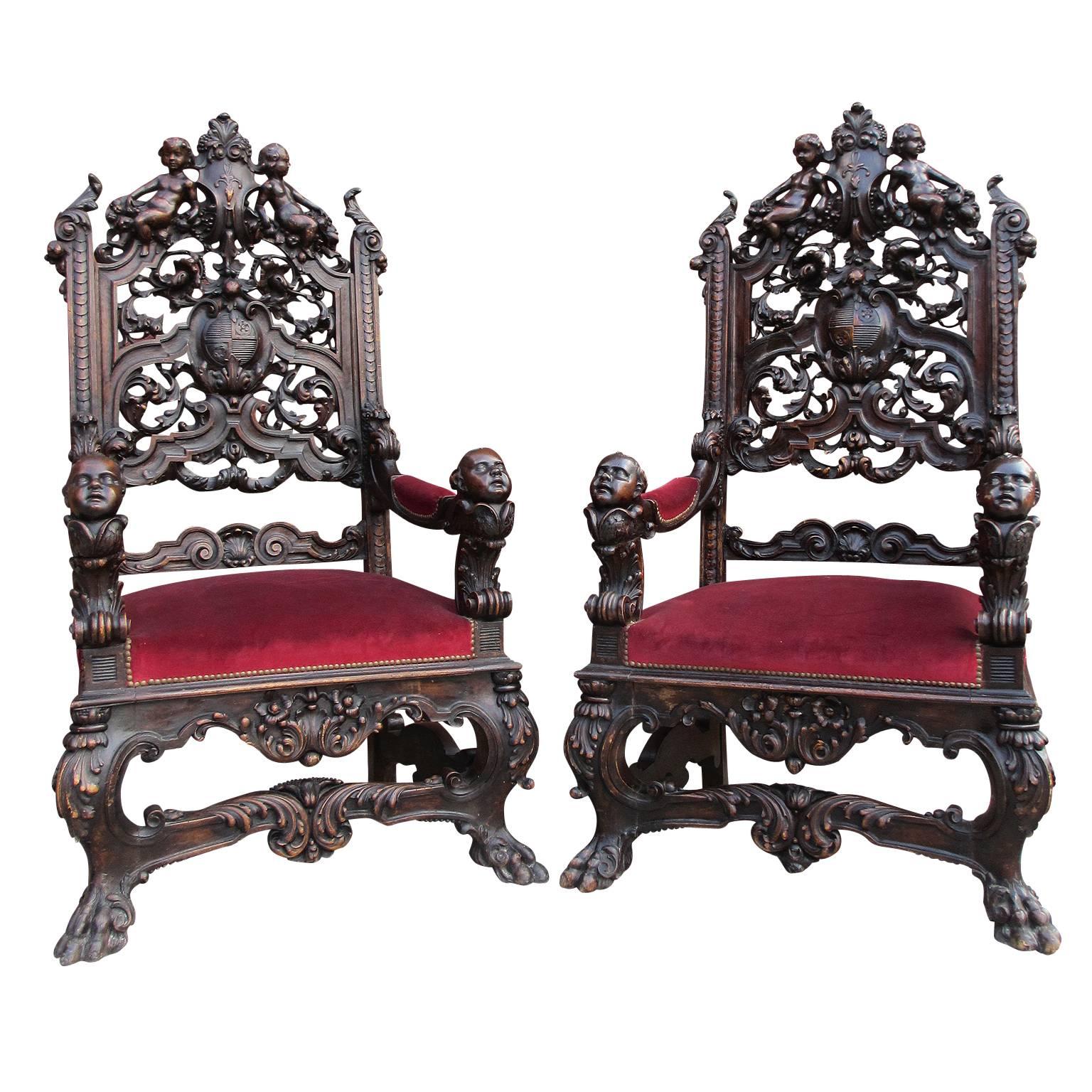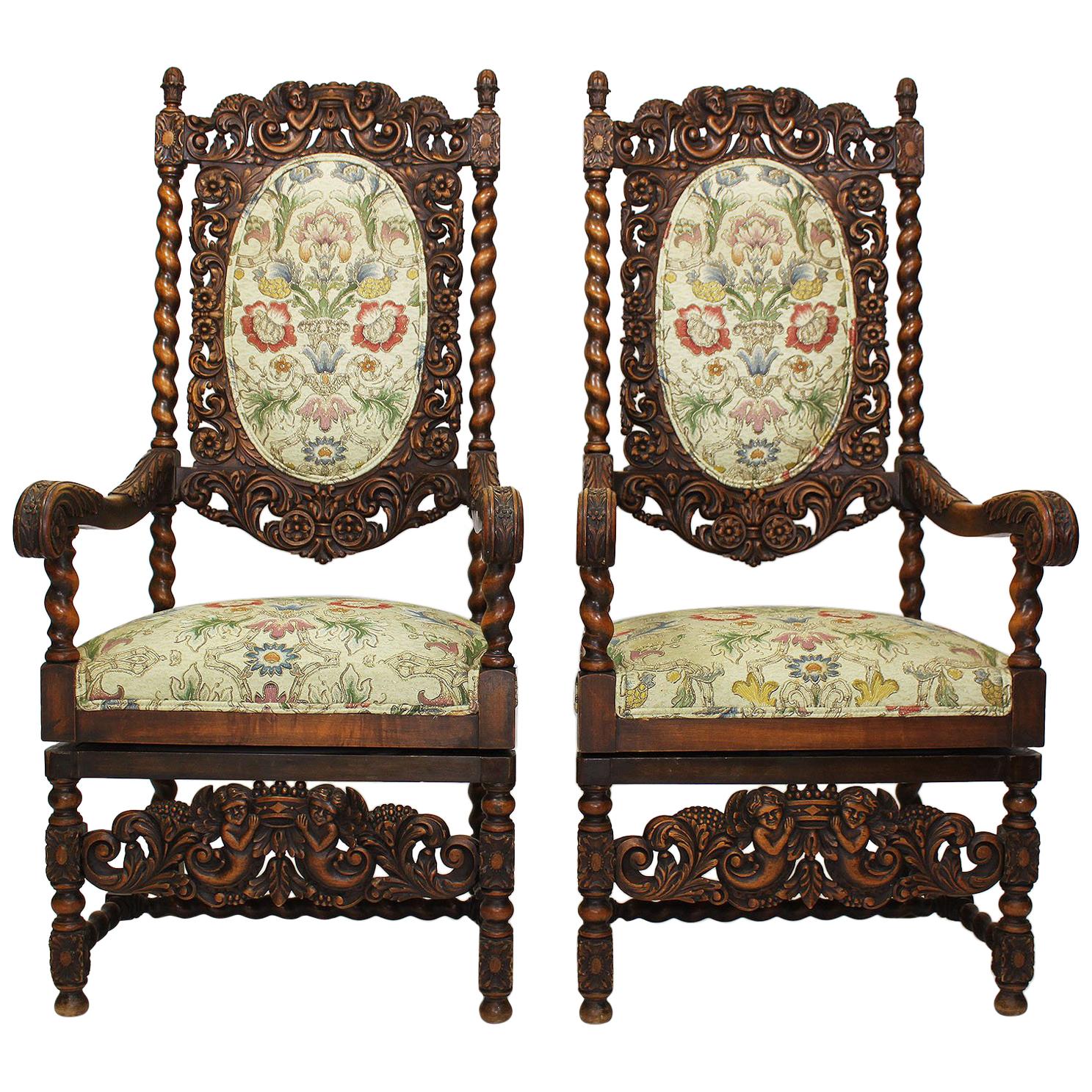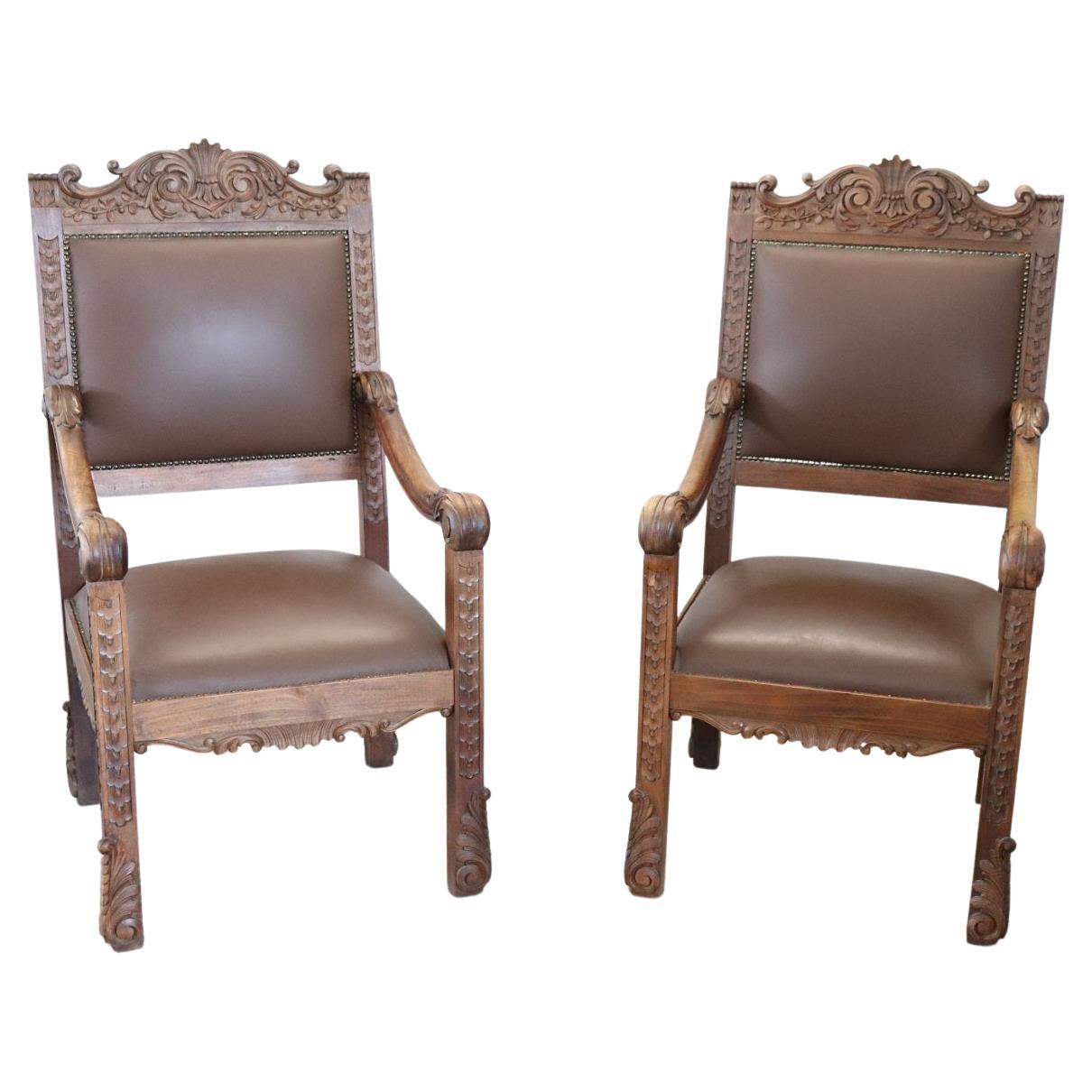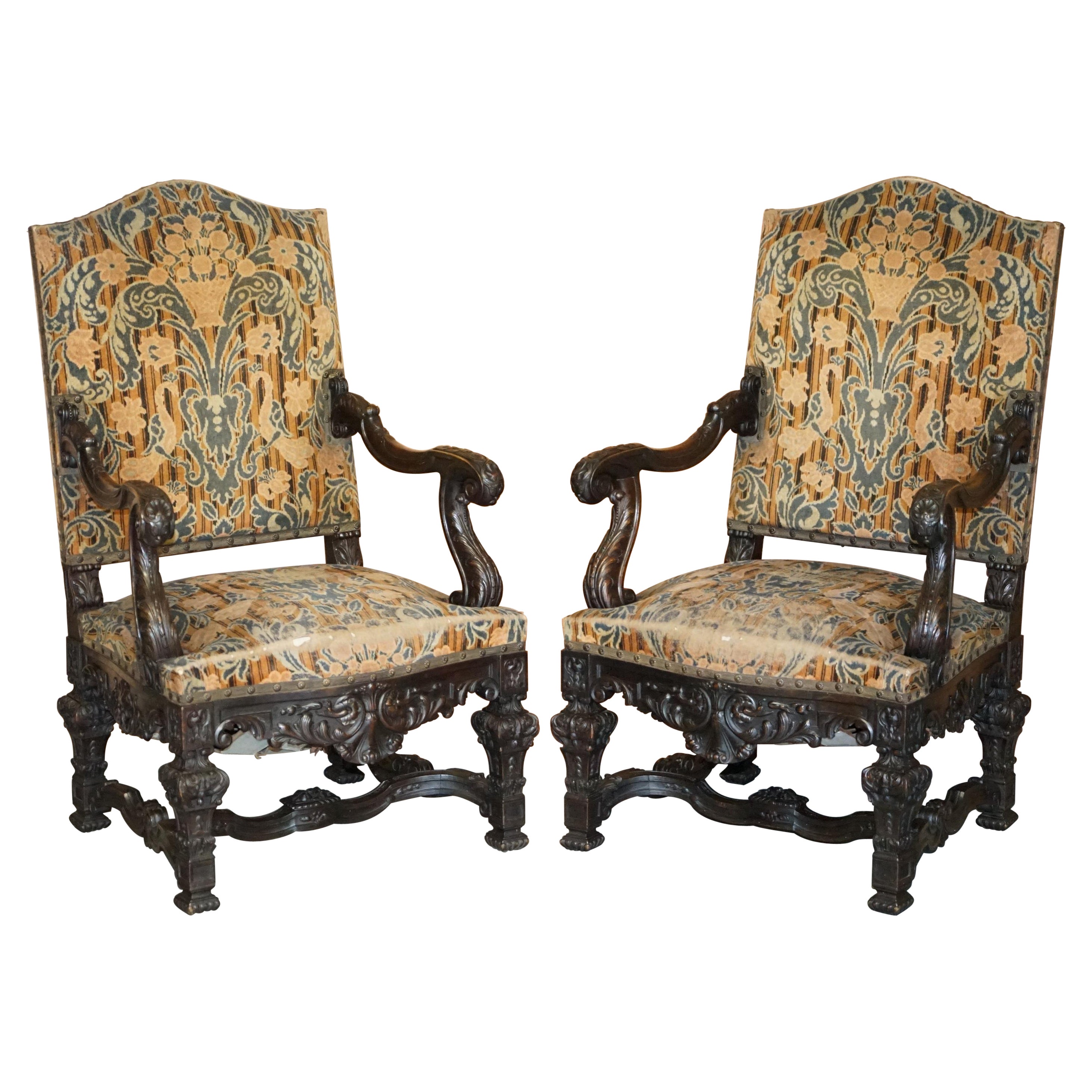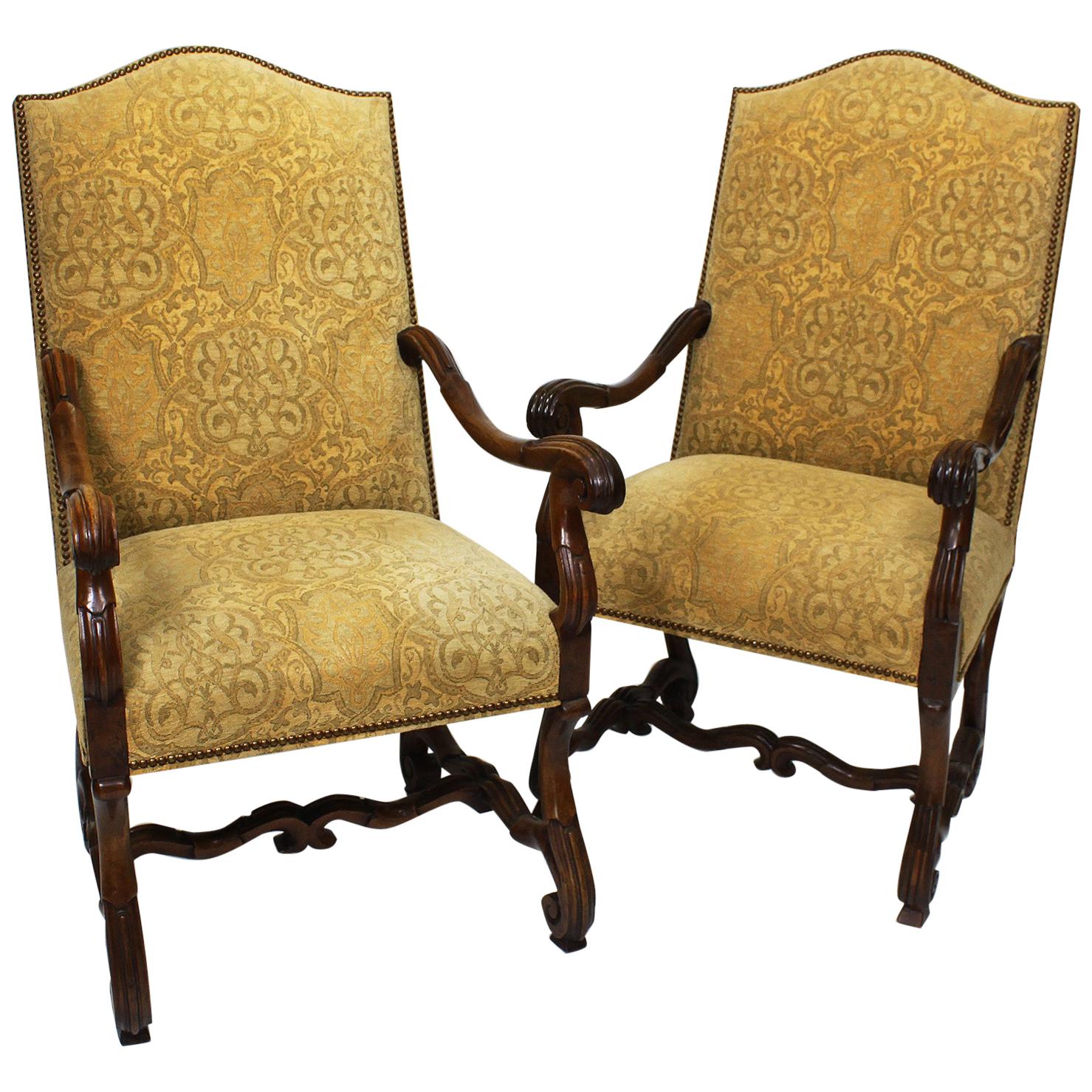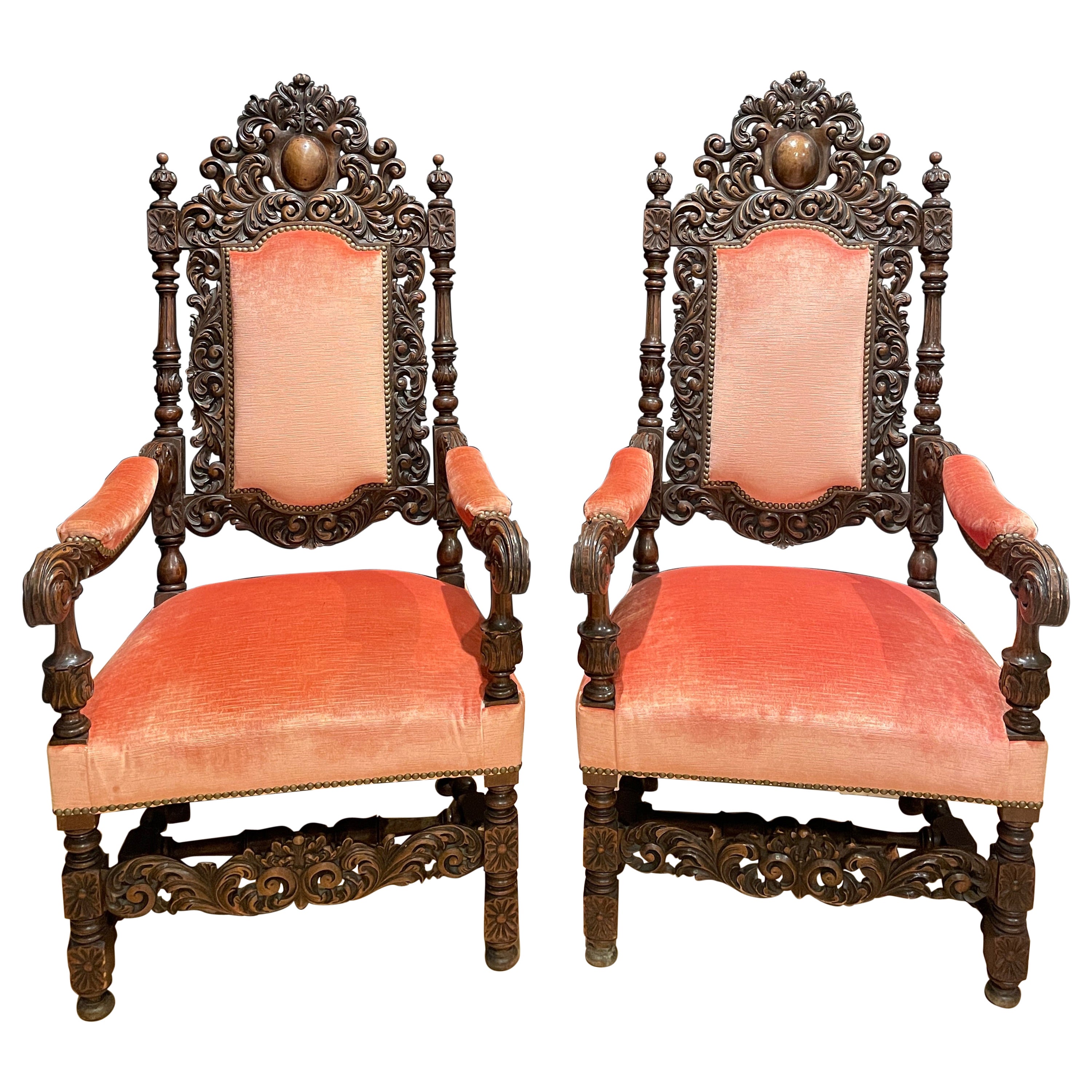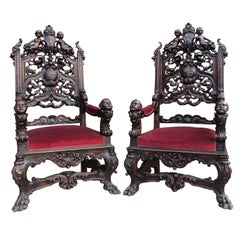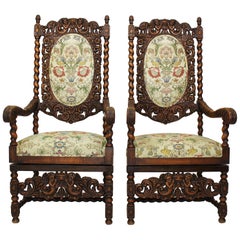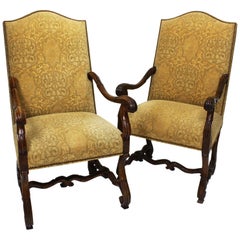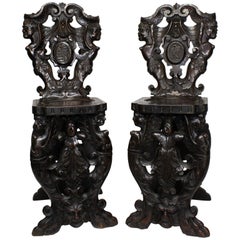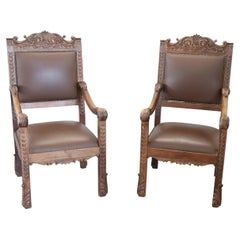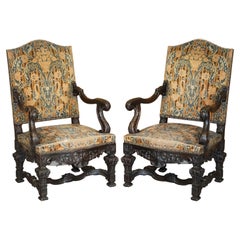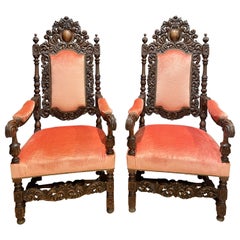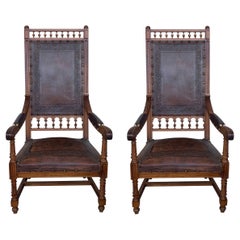Items Similar to Pair of Palatial Venetian Walnut Carved Mid-19th Century Baroque Figural Thrones
Video Loading
Want more images or videos?
Request additional images or videos from the seller
1 of 12
Pair of Palatial Venetian Walnut Carved Mid-19th Century Baroque Figural Thrones
$38,950per set
$75,000per set48% Off
£29,394.49per set
£56,600.44per set48% Off
€33,652.25per set
€64,798.94per set48% Off
CA$54,932.41per set
CA$105,774.87per set48% Off
A$60,308.94per set
A$116,127.61per set48% Off
CHF 31,463.30per set
CHF 60,584.02per set48% Off
MX$729,822.13per set
MX$1,405,305.77per set48% Off
NOK 394,343.66per set
NOK 759,326.68per set48% Off
SEK 371,575.40per set
SEK 715,485.38per set48% Off
DKK 251,205.08per set
DKK 483,706.82per set48% Off
About the Item
A very fine pair of palatial Venetian walnut carved mid-19th century Baroque figural throne armchairs, attributed to Valentino Panciera Besarel (Venice, 1829-1902) in the manner of Andrea Brustolon (1662-1732). The ornately carved thrones, each flanked with figures of standing males supporting a branch-carved armrests with vines. Raised on cabriolet scrolled legs. Provenance: The Castello di Giove in Umbria, Italy, circa 1870-1880.
Height: 54 1/4 inches (137.8 cm.)
Width: 37 1/4 inches (94.6 cm.)
Depth: 32 inches (81.3 cm.)
Andrea Brustolon (20 July 1662 – 25 October 1732) was an Italian sculptor in wood. He is known for his furnishings in the Baroque style and devotional sculptures.
Biography
He was trained in a vigorous local tradition of sculpture in his native Belluno, in the Venetian terraferma, and in the studio of the Genoese sculptor Filippo Parodi, who was carrying out commissions at Padua and at Venice (1677). He spent the years 1678-80 at Rome, where the High Baroque sculpture of Bernini and his contemporaries polished his style. Apart from that, the first phase of Brustolon's working career was spent in Venice, 1680–1685. Brustolon is documented at several Venetian churches where he executed decorative carving in such profusion that he must have quickly assembled a large studio of assistants. As with his contemporary in London, Grinling Gibbons almost all the high quality robust Baroque carving in Venice has been attributed to Brustolon at one time or another. In the Venetian Ghetto, at the Scola Levantina, Brustolon provided the woodwork for the synagogue on the piano nobile, where the carved, canopied bimah is supported on Solomonic columns, which Brustolon had seen in Bernini's baldacchino in the Basilica of St Peter's.
His furniture included armchairs with figural sculptures that take the place of front legs and armrest supports, inspired by his experience of Bernini's Cathedra Petri. The gueridon, a tall stand for a candelabrum, offered Brustolon unhampered possibilities for variations of the idea of a caryatid or atlas: the familiar Baroque painted and ebonized figural gueridons, endlessly reproduced since the eighteenth century, found their models in Brustolon's work.
His secular commissions from Pietro Venier, of the Venier di San Vio family (a suite of forty sculptural pieces that can be seen in the Sala di Brustolon of the Ca' Rezzonico, Venice), from the Pisani of Strà, and from the Correr di San Simeone families encourage the attribution to him of some extravagantly rich undocumented moveable furniture. Andrea Brustolon's elaborate carved furniture aspired towards the condition of sculpture, such as the Dutch bases for console tables which look like enlargements of the work of the two Van Vianens, Paulus and Adam, perhaps the greatest Dutch silversmiths of the period. These carved pieces display the baroque tendency to develop a form three-dimensionally in space.
Brustolon's walnut, boxwood and ebony pieces transcend ordinary functional limitations of furniture; they are constructed of elaborately carved figures. The framework of Brustolon's chairs, side tables and gueridons were carved as gnarled tree branches, with further supports of putti and male figures carved in ebony. Backrests of the chairs, which were never touched in the rigidly upright posture that contemporary etiquette demanded, were carved with allegories of vanity, fire and music, etc.
The most extravagant piece delivered for Pietro Venier was a large side table and vase-stand of box and ebony, designed as a single ensemble to display rare imported Japanese porcelain vases. The eclectic allegories include Hercules with the Hydra and Cerberus, males and reclining river-gods (see ref.).
For the Correr, less extrovert chairs bear female nudes extended along the armrests. For the Pisani, he carved a suite of twelve chairs (now at the Palazzo Quirinale) with flowers, fruit, leaves and branches to symbolize the twelve months of the year. Work by Brustolon is at the Villa Pisani at Stra.
In 1685 Brustolon returned to the house where he was born at Belluno, and from that time devoted himself mainly to tabernacles and devotional sculptures in walnut, boxwood or ivory. His polychromed ivory Corpus from a crucifix is in the Museo Civico di Belluno, which preserves some of Brustolon's preparatory drawings for frames to be carved with putti displaying emblems. A pair of boxwood sculptures, The Sacrifice of Abraham and Jacob Wrestling with the Angel, integral with scrolling barocchetto stands, were in the collection of Justus Liebig (Liebigshaus, Frankfort). An altarpiece, c. 1720, is at the Victoria and Albert Museum, London.
He died in Belluno in 1732.
Valentino Panciera Besarel (1829-1902) was Andrea Brustolon's great heir of the Nineteenth Century in wood carving; he presented himself as Brustolon's natural successor and alter ego. He studied from 1855 to 1857 in Venice and his career developed the most in there and in Belluno, although it was also turned to countries beyond the Alps. He applied in furniture and in ecclesiastical and secular decoration, showing his talents in furniture and frames making.
References:
Catalogue by Massimo de Grassi, Valentino Panciera Besarel, Verona, 2002) and was the subject of a monograph, Giovanni Angelini, Gli Scultori Panciera Besarel (Belluno 2002).
Biasuz G., and Buttignon M.G., 1969. Andrea Brustolon (Istituto Veneto Arti Grafiche) 1969
Gonzales-Palacios, Alvar, 1967. Il mobilio del '700 veneto
Semenzato, G., 1967. La scultura veneta del Seicento e del Settecento (Turin: Alfieri)
Valcanover, F., 1960. Indice delle opere d'arte della città e provincia di Belluno (Venice)
Biasuz, G., and E. Lacchin, 1928. Brustolon, preface by U. Ometti (Venice: Zanetti).
- Attributed to:Valentino Besarel (Workshop/Studio)
- Dimensions:Height: 54.25 in (137.8 cm)Width: 37.25 in (94.62 cm)Depth: 32 in (81.28 cm)Seat Height: 22 in (55.88 cm)
- Sold As:Set of 2
- Style:Baroque (In the Style Of)
- Materials and Techniques:
- Place of Origin:
- Period:
- Date of Manufacture:circa 1870-1880
- Condition:Repaired: Some minor repairs to carvings. Wear consistent with age and use. Minor losses. Minor fading. The frame and carving in great original condition with minor chipping and losses. There is some rubbing/fading on the armrests due to use. A few old pin-holes. The leather is worn and ripped, it should be replaced. Very sturdy and heavy frames.
- Seller Location:Los Angeles, CA
- Reference Number:Seller: Ref: A10121stDibs: LU179624469393
About the Seller
5.0
Vetted Professional Seller
Every seller passes strict standards for authenticity and reliability
Established in 1982
1stDibs seller since 2016
135 sales on 1stDibs
Typical response time: <1 hour
- ShippingRetrieving quote...Shipping from: Los Angeles, CA
- Return Policy
Authenticity Guarantee
In the unlikely event there’s an issue with an item’s authenticity, contact us within 1 year for a full refund. DetailsMoney-Back Guarantee
If your item is not as described, is damaged in transit, or does not arrive, contact us within 7 days for a full refund. Details24-Hour Cancellation
You have a 24-hour grace period in which to reconsider your purchase, with no questions asked.Vetted Professional Sellers
Our world-class sellers must adhere to strict standards for service and quality, maintaining the integrity of our listings.Price-Match Guarantee
If you find that a seller listed the same item for a lower price elsewhere, we’ll match it.Trusted Global Delivery
Our best-in-class carrier network provides specialized shipping options worldwide, including custom delivery.More From This Seller
View AllPair of Italian 19th Century Renaissance Style Carved Figural Throne Armchairs
Located in Los Angeles, CA
A fine and palatial pair of Italian 19th century renaissance style carved walnut figural throne armchairs. The intricately carved Baroque frames with the backrests depicting a pair o...
Category
Antique Late 19th Century Baroque Revival Armchairs
Materials
Velvet, Walnut
$24,850 Sale Price / set
29% Off
Pair of Italian 19th-20th Century Baroque Style Walnut Carved Throne Armchairs
Located in Los Angeles, CA
A fine pair of Italian 19th-20th century Baroque Revival style walnut figural carved high-back throne armchairs, each upholstered in a floral cream silk and gold fabric...
Category
Antique Early 1900s Italian Baroque Revival Armchairs
Materials
Fabric, Walnut
Pair of 19th Century Baroque Revival Style Carved Walnut Throne Armchairs
Located in Los Angeles, CA
A fine pair of Italian 19th century Baroque Revival style carved walnut throne armchairs. The high-back frames with recent upholstered back and seat and open carved scrolled armrests...
Category
Antique 19th Century Italian Baroque Revival Armchairs
Materials
Fabric, Walnut
Pair of Italian 19th Century Baroque Style Carved Walnut Sgabello Side Chairs
Located in Los Angeles, CA
A fine pair of Italian 19th century Baroque Revival style carved walnut Sgabello figural side-chairs, each backrest with carvings of winged male figures, the base with female figures...
Category
Antique 19th Century Italian Baroque Revival Chairs
Materials
Walnut
$3,950 Sale Price / set
38% Off
In Manner of Andrea Brustolon Venetian 19th Century Carved Walnut Figural Throne
By Valentino Besarel, Andrea Brustolon
Located in Los Angeles, CA
A fine Italian 19th century Baroque style carved walnut figural throne armchair, attributed to Valentino Panciera Besarel (Venice, 1829-1902) in the manner of Andrea Brustolon...
Category
Antique 19th Century Italian Baroque Armchairs
Materials
Fabric, Walnut
$12,950 Sale Price
29% Off
Fine Pair of Portuguese 19th Century Carved Walnut High Back Side Chairs
Located in Los Angeles, CA
A fine pair of Portuguese 19th century carved walnut high back side chairs. The ornately carved backrests with scrolls and floral design, raised on four cabriolet legs conjoined with...
Category
Antique Late 19th Century Portuguese Baroque Revival Chairs
Materials
Walnut
$3,960 Sale Price / set
20% Off
You May Also Like
Late 19th Century Italian Renaissance Style Carved Walnut Pair of Throne Chairs
Located in Casale Monferrato, IT
Impressive rare pair of throne chairs in perfect Italian Renaissance style, late 19th century. Made of solid walnut wood. The finely carved wooden backrest with very complex decorati...
Category
Antique 1880s Italian Renaissance Chairs
Materials
Faux Leather, Walnut
$7,706 Sale Price / set
20% Off
Stunning Pair of Hand Carved Italian Walnut Antique circa 1860 Throne Armchairs
Located in West Sussex, Pulborough
We are delighted to offer for sale this lovely pair of original Italian circa 1860 hand carved walnut throne armchairs with period upholstery
A wonderfully decorative and super or...
Category
Antique 1860s Italian High Victorian Armchairs
Materials
Walnut
Antique Pair of Carved Walnut Rococo Throne Chairs
Located in Norwood, NJ
A fine quality pair of hand carved walnut Host and Hostess throne chairs. Upholstered in a coral tone velvet. Carving with a center cabochon form cartouche surrounded by floral scrol...
Category
Antique Mid-19th Century Italian Rococo Armchairs
Materials
Upholstery, Wood, Walnut
Louis XVI Style Italian Pair of Carved Walnut Armchairs, 1900s
Located in Miami, FL
Louis XVI style pair of carved armchairs, Italy, 1900s
Good antique condition with some minor marks from used and age.
A set of two antique baroque side chairs hand-crafted out of walnut wood in a good condition. This set of dining chairs features a walnut color with a beautiful patina finish, hand-carved details through the entire frame, and intricated engraving leather...
Category
Antique Late 19th Century Italian Baroque Armchairs
Materials
Velvet, Walnut
Pair of Italian 19th Century Baroque Carved Arm Throne Chairs, Figural Carvings
Located in Manhasset, NY
Pair of Italian 19th century Baroque carved arm throne chairs. The pair with figural carvings and putti sleeping on beds of leafs, attributed to Valentino Panciera Besarel (Venice, 1829-1902) in the manner of Andrea Brustolon (1662-1732). The ornately carved thrones, each flanked with figures of standing males supporting a branch-carved armrests with vines. Raised on cabriolet scrolled legs.
Andrea Brustolon (20 July 1662–25 October 1732) was an Italian sculptor in wood. He is known for his furnishings in the Baroque style and devotional sculptures.
Biography
He was trained in a vigorous local tradition of sculpture in his native Belluno, in the Venetian terraferma, and in the studio of the Genoese sculptor Filippo Parodi, who was carrying out commissions at Padua and at Venice (1677). He spent the years 1678-1680 at Rome, where the High Baroque sculpture of Bernini and his contemporaries polished his style. Apart from that, the first phase of Brustolon's working career was spent in Venice, 1680–1685. Brustolon is documented at several Venetian churches where he executed decorative carving in such profusion that he must have quickly assembled a large studio of assistants. As with his contemporary in London, Grinling Gibbons almost all the high quality robust Baroque carving in Venice has been attributed to Brustolon at one time or another. In the Venetian Ghetto, at the Scola Levantina, Brustolon provided the woodwork for the synagogue on the piano nobile, where the carved, canopied bimah is supported on Solomonic columns, which Brustolon had seen in Bernini's baldacchino in the Basilica of St Peter's.
His furniture included armchairs with figural sculptures that take the place of front legs and armrest supports, inspired by his experience of Bernini's Cathedra Petri. The gueridon, a tall Stand for a candelabrum, offered Brustolon unhampered possibilities for variations of the idea of a caryatid or atlas: the familiar Baroque painted and ebonized figural gueridons, endlessly reproduced since the 18th century, found their models in Brustolon's work.
His secular commissions from Pietro Venier, of the Venier di San Vio family (a suite of forty sculptural pieces that can be seen in the Sala di Brustolon of the Ca' Rezzonico, Venice), from the Pisani of Strà, and from the Correr di San Simeone families encourage the attribution to him of some extravagantly rich undocumented moveable furniture. Andrea Brustolon's elaborate carved furniture aspired towards the condition of sculpture, such as the Dutch bases for console tables which look like enlargements of the work of the two Van Vianens, Paulus and Adam, perhaps the greatest Dutch silversmiths of the period. These carved pieces display the Baroque tendency to develop a form three-dimensionally in space.
Brustolon's walnut, boxwood and ebony pieces transcend ordinary functional limitations of furniture; they are constructed of elaborately carved figures. The framework of Brustolon's chairs, side tables and gueridons were carved as gnarled tree branches, with further supports of putti and male figures carved in ebony. Backrests of the chairs, which were never touched in the rigidly upright posture that contemporary etiquette demanded, were carved with allegories of vanity, fire and music, etc.
The most extravagant piece delivered for Pietro Venier was a large side table and vase-stand of box and ebony, designed as a single ensemble to display rare imported Japanese porcelain vases. The eclectic allegories include Hercules with the Hydra and Cerberus, males and reclining river-gods (see ref.).
For the Correr, less extrovert chairs bear female nudes extended along the armrests. For the Pisani, he carved a suite of twelve chairs (now at the Palazzo Quirinale) with flowers, fruit, leaves and branches to symbolize the twelve months of the year. Work by Brustolon is at the Villa Pisani at Stra.
In 1685 Brustolon returned to the house where he was born at Belluno, and from that time devoted himself mainly to tabernacles and devotional sculptures in walnut, boxwood or ivory. His polychromed ivory Corpus from a crucifix is in the Museo Civico di Belluno, which preserves some of Brustolon's preparatory drawings for frames to be carved with putti displaying emblems. A pair of boxwood sculptures, The Sacrifice of Abraham and Jacob Wrestling with the Angel...
Category
Antique 1890s Italian Baroque Armchairs
Materials
Wood
Pair of Figural Carved Walnut R.J. Horner Style Renaissance Chairs, circa 1880
Located in Swedesboro, NJ
This pair of figural carved walnut Renaissance Revival chairs, circa 1880, in the style of R.J. Horner, showcases the dramatic artistry and craftsmanship associated with 19th-century...
Category
Antique 1880s European Renaissance Revival Chairs
Materials
Walnut
$1,200 Sale Price / set
20% Off
More Ways To Browse
Alps Furniture
Rare Japanese Porcelain
Three Piece Suite Mid Century
Grinling Gibbons
Console Table Bases
Side Table 32 Inches Tall
Venetian Carved Figure
Ivory Crucifix
Eric Lyons
Erich Dieckmann Rattan Armchair
Erik Kirkegaard Model 52
Ernest Race Heron
Esfera Armchair
Fauteuil Paquebot Vintage
Fauteuil Safari
Faux Bamboo Tub Chairs
Finn Juhl 109
Finn Juhl 48 Chair
